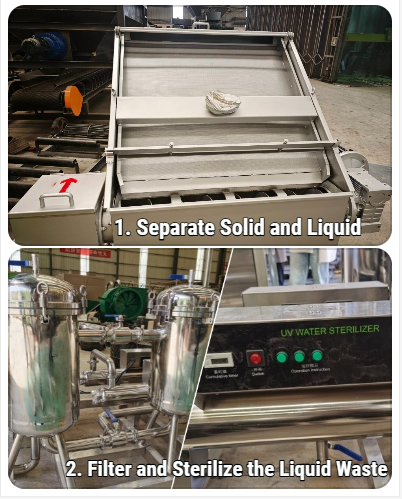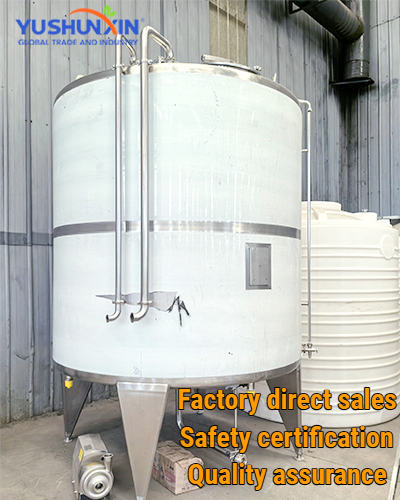The main structure of YUSHUNXIN liquid fertilizer anaerobic fermentation tank
YUSHUNXIN’s liquid fertilizer anaerobic fermenter integrates multiple key components, each contributing to stable performance and efficient fermentation.
Tikina he otingaLiquid Fertilizer Anaerobic Fermentation Tanks efficiently process a wide range of liquid raw materials, including livestock waste, biogas slurry, and other nutrient-rich liquid substrates. In the liquid fertilizer production process, these fermenters break down organic matter, enhance nutrient availability, and create a stable base for high-quality liquid fertilizer. YUSHUNXIN provides anaerobic fermentation tanks in various capacities, from small-scale 500 L units to large 50,000 L systems, allowing you to match equipment to your production needs. Our tanks feature precise temperature control, integrated stirring, and automated cleaning systems, ensuring uniform fermentation. By choosing YUSHUNXIN, you get efficient, durable, and cost-effective liquid fertilizer production equipment.
YUSHUNXIN’s liquid fertilizer anaerobic fermenter integrates multiple key components, each contributing to stable performance and efficient fermentation.
Tikina he otinga
When using liquid fertilizer anaerobic fermentation tank, the process is simple and efficient. You canturn organic liquid waste into high-value fertilizer with ease. Tuatahi, use a pump to feed the liquid waste into the machine's sealed inlet to prevents air from entering. Kei roto i te tank, heating and stirring systems keep the raw material at a steady temperature, usually 35℃–50℃. This creates the best conditions for microbial fermentation. Depending on your material, the process takes about 3-5 ra. During this time, you can also add fermentation promoters (Molasses, fermentation bacteria) through the dosing system. After fermentation, the finished liquid flows out smoothly from the discharge outlet.
Tikina he otingaCareful preparation in these two steps effectively improves fermentation performance and lays the foundation for high-quality liquid fertilizer manufacturing.
Divide organic raw materials into solid and liquid parts. Using a solid-liquid separation equipment is an excellent choice to obtain the liquid fraction, which contains the main nutrients for liquid fertilizer. You can then use a sediment tank to collect the liquid waste.
Muri atu, filter the liquid to remove debris, stones, and large particles. Kātahi, use a UV sterilizer to eliminate harmful microbes. This step ensures a safer fermentation process and prevents unwanted odors. Rawa, you can produce a cleaner and more consistent liquid fertilizer product.

The price of an Anaerobic Fermentation Tank for liquid fertilizer production usually falls between $8,000 me $30,000. The final cost depends on several key factors. Such as tank capacity, material selection, automatic level, and structure design.
Tank capacity plays the biggest role. The smaller-scale liquid fertilizer fermentation costs less, while larger tanks with higher output require thicker steel plates. Material selection also affects the price. Many buyers choose standard 304 kowiri tira, while 316 stainless steel offers higher corrosion resistance for fish protein, amino acids, or high-salt formulations.
Automation level further influences the cost of the anaerobic fermentation pot. A basic tank includes a heating jacket and a standard mixer, but a fully automated system integrates PLC control, digital sensors, pH monitoring, and auto-temperature regulation. Hei taapiri, structural design also matters. Clients producing dense or viscous liquid fertilizers often need reinforced mixing blades, anti-sedimentation structures, and CIP-friendly internal surfaces.
YUSHUNXIN supports full customization for anaerobic fermentation system. You can select tank volume, mixer type, insulation layer, heating system, or monitoring devices according to your raw materials and process requirements. A well-designed anaerobic fermentation tank reduces operation cost, improves nutrient conversion, and strengthens product consistency in your liquid fertilizer manufacturing line.

Whiwhi i nga taputapu whakangahau koreutu me nga taipitopito hua, me te pai ki nga ratonga kua whakaritea-kotahi.
Waiho to korero
 Whakahua
Whakapā
Whakahua
Whakapā
Kaore e taea e koe te kape i nga tuhinga o tenei whaarangi